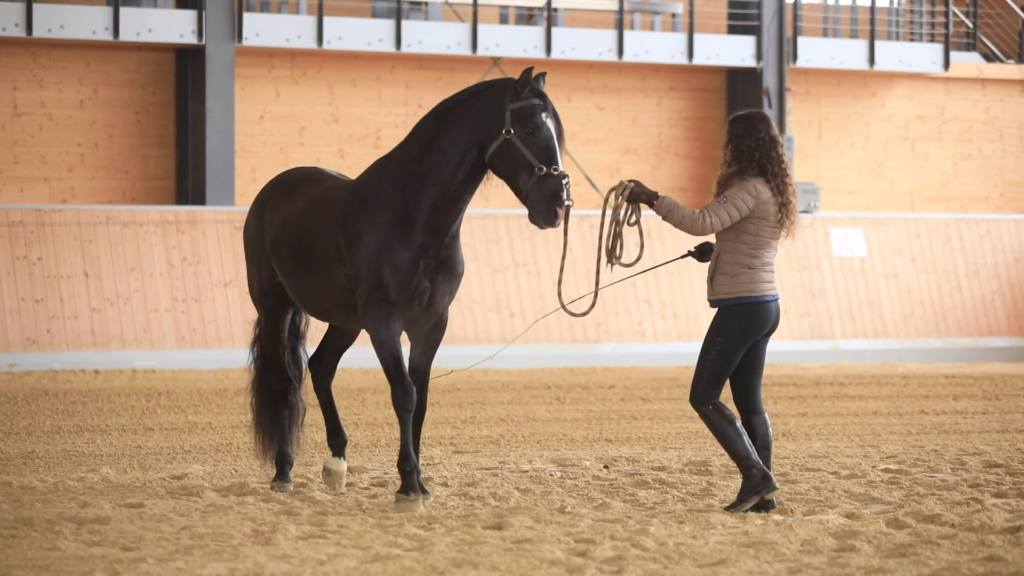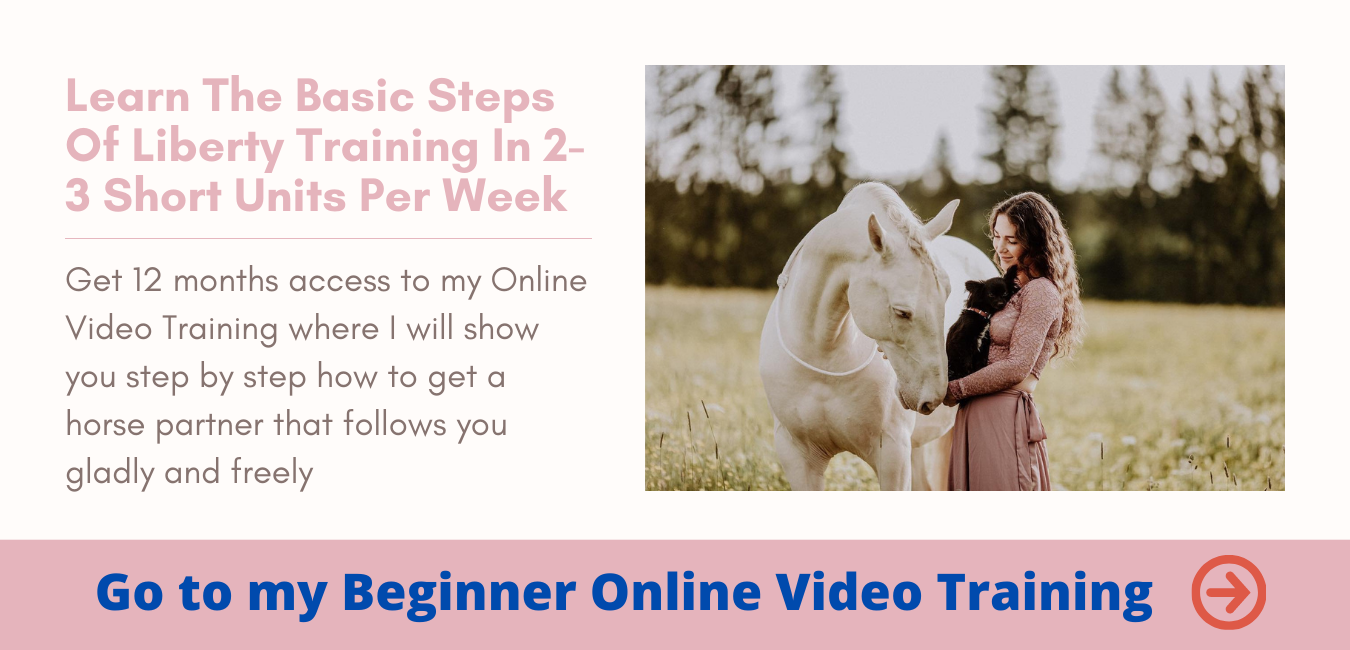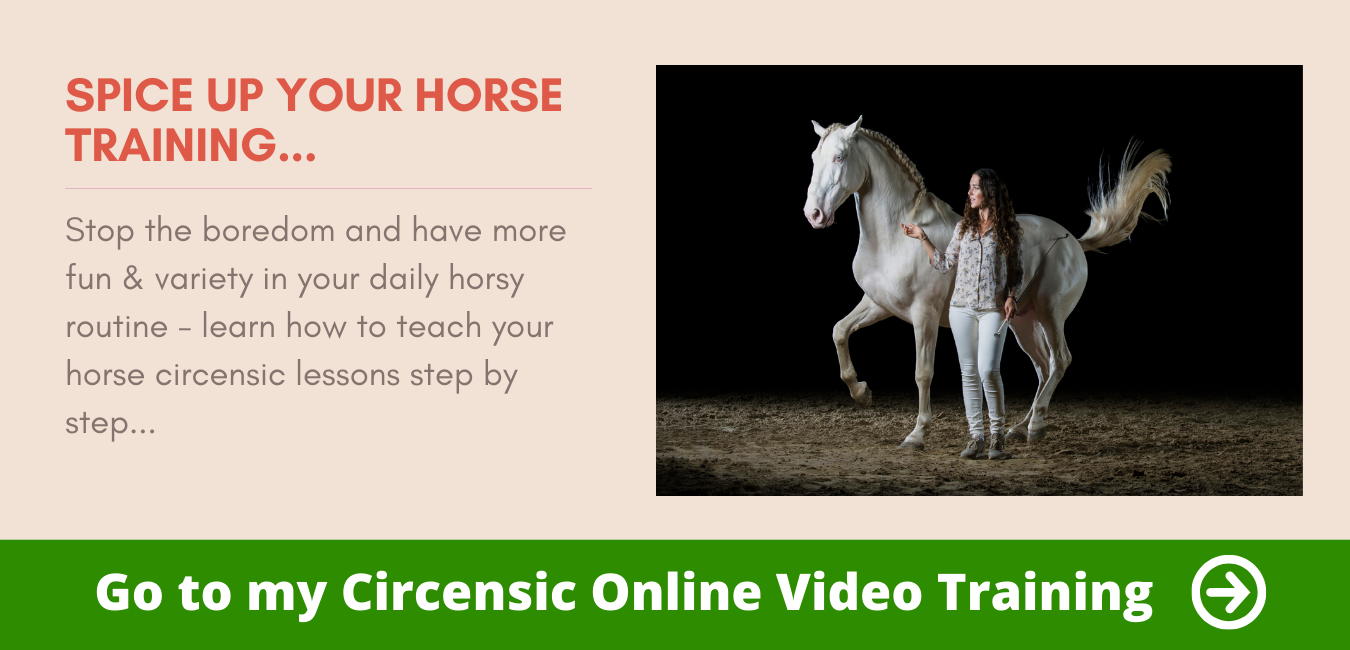Have you already noticed a difference in your horse when he drops his head and neck and chews relaxed?
Of course we can also achieve this relaxed “end goal” through good riding – but how nice is it when the shortcut discussed in the last blog also exists for us and our horse?
And we can, so to speak, already start much more relaxed into the training itself?
Once your horse has understood the impulse downwards on the cavesson or the chewing exercise on the snaffle in the stance, you can move on to asking for both impulses in the movement and work with your horse on large circles.
By the way, we are now in the classical handwork – because you can basically work on every lesson under saddle from the ground first.
But let’s stay with our circle ?
Bending and positioning on the circle
You now walk with your horse in a forward-downward position along a circle.
Now try to increase and decrease the size of your circle.
You will notice that especially on a smaller circle your horse will drift out with his head and push in with his shoulder.
Our aim now is to explain to the horse that he should lift the inside shoulder and bend – like a train with several carriages – in order to walk on the circle in a way that is gentle on the joints and gymnastically valuable.
To do this, touch the inner shoulder with the whip until your horse tips his shoulder outwards (or into balance) and praise him for the correct reaction.
By the way, if your horse does not understand what reaction you want him to have when you touch him, this can help:
Practice forehand and hindquarter yielding first.
In other words, teach your horse to yield to the touch of a certain point on the hindquarters while the forehand remains standing and to yield to the touch of the shoulder while the hindquarters remain standing.
You can then also use this point on the shoulder to encourage your horse to give way or lift the shoulder in bend and stance on the circle line.
Praise your horse again at the beginning for the smallest correct impulse!
Increase the duration gradually when your horse has understood what you want him to do.
From leading to lunging
As time goes by, you should try not to lead your horse directly, but to increase the distance between you – and still keep the “railway look”.
It can help if you set up a few small cones or poles in the desired size of the circle.
This will give your horse a visual indication of where you want to go. You can also do cool exercises with the cones later!
But I will go into that in the next blog post.
If you have now gradually increased the distance between you and your horse, you are practically already in the middle of lunging!
Then it is often only a challenge to maintain the bend in trot and canter.
Of course, this won’t work in the long run at the beginning – your horse needs the necessary strength at first – but you can gradually extend the phases.
By the way, it has often helped me a lot to reduce the distance between me and my horse at the beginning of the trot.
The closer you are, the more you can influence your horse and praise the loose and bent trot more quickly and specifically.
For this I either use a voice praise!
Important: Your horse should not stop as soon as you praise him, but be familiar with a so-called “progressive praise” during an exercise.
And of course I am very happy about every correct step that my horse gives me.
Or reward it again with a break in the walk.
What is the right way for your horse depends of course on his character – but you know your horse best.
It can also be a praise to be allowed to really let off steam on the lunge line after all the concentration.
There are no limits to your imagination when it comes to praise!
If you still find it difficult to see whether your horse is correctly bent and positioned, it can help to move your horse’s head while standing and to see when and how his hips bend.
The curved line should go evenly through the whole body of the horse – the neck should not be bent and therefore overhanging.
The position of your horse’s head is also really only “centimetre work”.
We almost always tend to ask for “too much”.
Therefore, train your eye whenever possible to be able to recognise the correct bend and position for your horse’s body.
If trotting in hand works well, you can increase the distance between you and your horse again.
It often helps if you have already linked the impulse on the cavesson to lower the head with a voice signal close by, because you can also give this signal easily from a distance.
In order to remind your horse to lift his shoulder at a distance, it helps if you touch the point with a longer whip from a distance and then, in the long run, just point to it.
Through your preparation your horse already knows what you want from him.
[su_youtube url=”https://youtu.be/eDDaKrBpyes”]
You will see that the phases in which your horse runs more and more balanced and bent will become longer and longer over time.
I hope you have lots of fun practising!
All the love,
Your Kenzie




